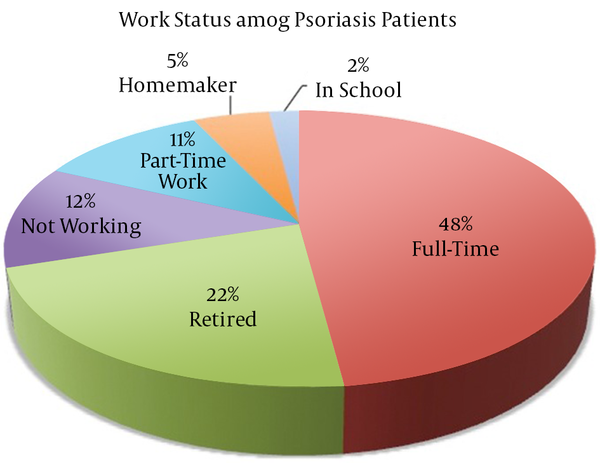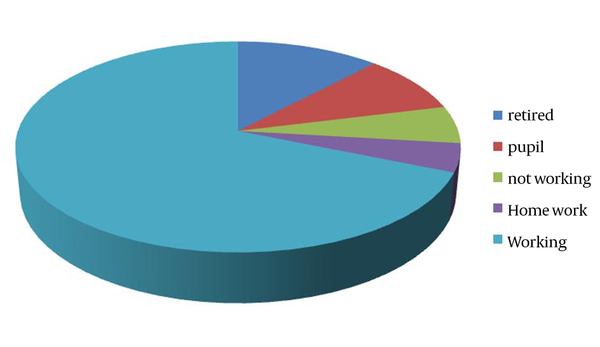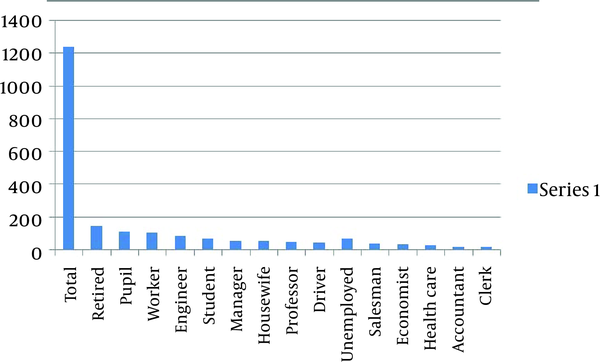Abstract
Background:
Psoriasis is a systemic, immune-mediated disease, associated with significant comorbidities, with a high negative impact on the quality of life.Objectives:
The aim of this study was to evaluate the profession of patients diagnosed with psoriasis and establish a correlation between the disease and occupation.Patients and Methods:
In an outpatient clinic, 1236 patients were diagnosed with psoriasis during eight years (2004-2011) and followed up for different clinical parameters and details in their working places.Results:
Of 1236 patients, 669 were male (54.13%) and 567 (45.87%) female, with a predominance of male over female (1.18/1); the median age at diagnosis was 29.34 ± 15.24; the retired individuals were mostly representatives (149, 12.6%), followed by pupils (112, 9.06%), employees (108, 8.74%), engineers (87, 7.04%), students (70, 5.66%), managers (56, 4.53%), housewives (54, 4.37%), professors (53, 4.28%), drivers (46, 3.72%), salesmen (39, 3.16%), economists (38, 3.07%), healthcare professionals (32, 2.59%). Others were unemployed (71 - 8.77%) or had other occupations.Conclusions:
The results did not conclusively declare psoriasis as an occupational or occupational-induced disease.Keywords
1. Background
Psoriasis is a systemic chronic inflammatory disease with a significant impairment on quality of life and work productivity (1). Great majority of patients with psoriasis complain of self-consciousness, embarrassment, depression, social isolation, stigmatization (2, 3), and significant impairment of work productivity (4, 5).
2. Objectives
The impact of psoriasis on quality of personal and professional life is well recognized. The aim of this study was to find a correlation between psoriasis and working place or job of the patients.
3. Patients and Methods
A retrospective study was conducted on 1236 patients with psoriasis in a single center, managing psoriasis during 2004-2011. The patients were examined in an outpatient Clinic by trained dermatologists and the following variables were noted: age, gender, age at diagnosis, family history of psoriasis, residence, level of education, job. Diagnosis of psoriasis was based on clinical grounds, and when necessary, it was certified by skin biopsy. The patients were asked to fill in some questionnaires and the personal data were collected.
4. Results
Our results confirmed the high prevalence of psoriasis in working people as 65.74%; retired persons: 12.06%, pupils: 9.06%, home workers or housewives: 4.37%; unemployed individuals: 8.77% (Table 1).
Job Distribution of Patients With Psoriasis
| Job | No. (%) | Job | Nr | No. (%) | Job | Nr | (%) | |
|---|---|---|---|---|---|---|---|---|
| Retired | 149 | 12.06 | Policeman | 5 | 0.40 | Cameraman | 1 | 0.08 |
| Pupil | 112 | 9.06 | Nurse | 4 | 0.32 | Railway man | 1 | 0.08 |
| Employee | 108 | 8.74 | Social Assistance | 3 | 0.24 | Legal adviser | 1 | 0.08 |
| Engineer | 87 | 7.04 | Attorney | 3 | 0.24 | constructor | 1 | 0.08 |
| Student | 70 | 5.66 | Librarian | 3 | 0.24 | Builder | 1 | 0.08 |
| Manager | 56 | 4.53 | Chef/cook | 3 | 0.24 | Cosmetician | 1 | 0.08 |
| Housewife | 54 | 4.37 | Registrar | 3 | 0.24 | Typist | 1 | 0.08 |
| Professor | 53 | 4.28 | Inspector | 3 | 0.24 | Butcher | 1 | 0.08 |
| Driver | 46 | 3.72 | School teacher | 3 | 0.24 | Designer | 1 | 0.08 |
| Unemployed | 71 | 8.77 | Businessman | 3 | 0.24 | Dispatcher | 1 | 0.08 |
| Salesman | 39 | 3.16 | Postman | 3 | 0.24 | Physiotherapist | 1 | 0.08 |
| Economist | 38 | 3.07 | Foreman | 3 | 0.24 | Sketcher | 1 | 0.08 |
| Healthcare worker | 32 | 2.59 | Welder | 3 | 0.24 | Plumber | 1 | 0.08 |
| Accountant | 22 | 1.78 | Adviser/consultant | 3 | 0.24 | Planner | 1 | 0.08 |
| Clerk | 22 | 1.78 | Veterinary assistant | 2 | 0.16 | Warrant officer | 1 | 0.08 |
| Technician | 21 | 1.70 | Bartender | 2 | 0.16 | Storekeeper | 1 | 0.08 |
| Physician | 17 | 1.38 | Tradesman | 2 | 0.16 | Nun | 1 | 0.08 |
| Mechanic | 17 | 1.38 | Security agent | 2 | 0.16 | Meteorologist | 1 | 0.08 |
| Electrician | 13 | 1.05 | Pharmacist | 2 | 0.16 | Miner | 1 | 0.08 |
| Farmer | 10 | 0.81 | Physicist | 2 | 0.16 | Curator | 1 | 0.08 |
| Secretary | 9 | 0.73 | Barber | 2 | 0.16 | Forester | 1 | 0.08 |
| Administrator | 8 | 0.65 | Judge | 2 | 0.16 | Guardian | 1 | 0.08 |
| Cleric | 8 | 0.65 | Machinist | 2 | 0.16 | Fireman | 1 | 0.08 |
| Computer programmer | 8 | 0.65 | Supervisor | 2 | 0.16 | Driving instructor | 1 | 0.08 |
| Lawyer | 7 | 0.57 | Waiter | 2 | 0.16 | Psychologist | 1 | 0.08 |
| Cashier | 7 | 0.57 | Carpenter | 2 | 0.16 | Reviser | 1 | 0.08 |
| Sales agent | 7 | 0.57 | Forester | 2 | 0.08 | Reporter | 1 | 0.08 |
| Chemist | 6 | 0.49 | Insurance agent | 1 | 0.08 | Sociologist | 1 | 0.08 |
| Officer | 6 | 0.49 | Analyst | 1 | 0.08 | Trainer | 1 | 0.08 |
| Referent | 6 | 0.49 | Town clerk | 1 | 0.08 | |||
| Governess | 5 | 0.40 | Pharmacy assistant | 1 | 0.08 | |||
| Analyst | 5 | 0.40 | Biologist | 1 | 0.08 | |||
| Soldier | 5 | 0.40 | Furrier | 1 | 0.08 | |||
| Operator | 5 | 0.40 | Baker | 1 | 0.08 | |||
5. Discussion
An occupational disease is defined as one that is caused or worsened by working (6). The terminology of occupationally-induced psoriasis was used by Moroni in 1998 (7), who reported 1.2% of all occupational dermatoses as work-related psoriasis (3000 patients were enrolled in the study). A German study on 1901 patients with occupational dermatoses in 2009 by Skudlik et al. (8) showed that 73 patients (3.8%) were diagnosed with psoriasis of the hands; in 42 cases (2.2%), a profession-related context was admitted (mechanical repeated microtrauma, wet conditions of work, contact with irritants). It is now admitted that pressure, trauma, and work-related friction may cause psoriasis of hands and fingers (9). A number of papers have been published during the last decades concerning the idea of occupational psoriasis (mostly palmar-type) (9-12). A list of professions with high incidence of work-related psoriasis was published (9-12), including the following risky jobs: baker, barkeeper, bookbinder, bus driver, cashier, cleaner, construction worker, dentist, draftsman, electrician, joiner, manufacturing/packaging worker, masseur, mechanic, newspaper vendor, pharmacist, seamstress, and tailor (13). A more recent study was published in the USA by the National Psoriasis Foundation, survey data of 2003–2011 (2), and pointed out that psoriasis was prevalent in working people (64%) (full-time workers: 48%; part-time workers: 11%; homemakers: 5%). Retired people were diagnosed with psoriasis in 22% of cases, jobless people in 12%, and children attending school in 2%. No details about specific activities of psoriasis patients were reported (Figure 1). Psychosocial stress may play a role in exacerbation of psoriasis (14); also, alcohol consumption may correlate with prevalence of psoriasis in working people.
A slight increase in prevalence of psoriasis in farmers exposed to pesticides was verified in India in 2011 (15); but further studies must be performed following this pathway. Geographic variations and climatic factors such as sun exposure and humidity could influence the prevalence of psoriasis and explain (among other factors) the variability of disease incidence all over the world (16). Work-related physical activity is proved to be correlated with onset of psoriatic arthritis (17). Table 2 shows the latest distribution of population in Romania. The present study was performed on 1236 patients diagnosed with psoriasis during an eight-year period (2004-2011) in the north-eastern part of Romania, covering approximately one third of the population. The results revealed the high prevalence of psoriasis in working people as 65.74%; retired persons: 12.06%; pupils: 9.06%; home workers (housewives): 4.37%; unemployed people: 8.77% (Figure 2).
A deeper look inside the study put in evidence the specific repartition among jobs: simple workers (with no qualification and hard work): 8.74%; engineers: 7.04%; students: 5.66%; managers: 4.53%; professors: 4.28%; drivers: 3.72%; salesmen: 3.16%; economists: 3.07%; medical carriers: 2.59% (Tabel 1) (Figure 3). Fenomen Koebner was observed in 173 patients (14%). Palmar involvement was the type of psoriasis recognized in 205 patients (16.59%) (Table 3). Our data confirmed the high prevalence of psoriasis in working people, especially ones with stressful activities: engineers, students, professors, managers, drivers, salesmen, and medical staff.
Physical activity, alcohol consumption, smoking, working place pollution, repeated trauma, and irritants are linked to psoriasis in workers. Retired persons encounter frequent manifestations of psoriasis after a long evolution of the disease (psoriasis march); they spend time and money to search for medical help. Chronic infections, comorbidities, and drug administration could be triggering factors for psoriasis flares. The results did not conclusively declare psoriasis as an occupational or occupational-induced disease and further studies will be required.
Demographic Data in Romania
| Parameter | Case, No. (%) |
|---|---|
| Total Population in 2011 | 20.121.641 (100) |
| Females | 10.333.064 (51.4) |
| Retired Persons | 5.487.000 (27.2) |
| Not working/jobless Individuals | 744.000 (3.69) |
Type of Psoriasis and Distribution of Lesions
| Type of Psoriasis | Case, No. (%) |
|---|---|
| Nail Psoriasis | 165 (13.35%) |
| Psoriatic Arthritis | 309 (25.00%) |
| Koebner Phenomenon | 173 (14.00%) |
| Scalp Psoriasis | 681 (55.10) |
| Guttate Psoriasis | 146 (11.81) |
| Superior Limbs | 788 (63.75) |
| Inferior Limbs | 736 (59.55) |
| Trunk | 462 (37.38) |
| Face | 55 (4.45) |
| Palmoplantar | 205 (16.59) |
| Others | 265 (21.44) |
| Total | 1236 (100) |
National Psoriasis Foundation Survey Data, 2003–2011 (2), USA

Working Status Among Psoriasis Patients in Romania

Specific Repartitions of Jobs

References
-
1.
Armstrong AW, Schupp C, Wu J, Bebo B. Quality of life and work productivity impairment among psoriasis patients: findings from the National Psoriasis Foundation survey data 2003-2011. PLoS One. 2012;7(12). [PubMed ID: 23285231]. https://doi.org/10.1371/journal.pone.0052935.
-
2.
Gupta MA, Gupta AK, Watteel GN. Perceived deprivation of social touch in psoriasis is associated with greater psychologic morbidity: an index of the stigma experience in dermatologic disorders. Cutis. 1998;61(6):339-42. [PubMed ID: 9640555].
-
3.
Schmid-Ott G, Jaeger B, Kuensebeck HW, Ott R, Lamprecht F. Dimensions of stigmatization in patients with psoriasis in a "Questionnaire on Experience with Skin Complaints'. Dermatology. 1996;193(4):304-10. [PubMed ID: 8993954].
-
4.
Pearce DJ, Singh S, Balkrishnan R, Kulkarni A, Fleischer AB, Feldman SR. The negative impact of psoriasis on the workplace. J Dermatolog Treat. 2006;17(1):24-8. [PubMed ID: 16467020]. https://doi.org/10.1080/09546630500482886.
-
5.
Horn EJ, Fox KM, Patel V, Chiou CF, Dann F, Lebwohl M. Association of patient-reported psoriasis severity with income and employment. J Am Acad Dermatol. 2007;57(6):963-71. [PubMed ID: 17761358]. https://doi.org/10.1016/j.jaad.2007.07.023.
-
6.
Cherry N. Recent advances: occupational disease. BMJ. 1999;318(7195):1397-9. [PubMed ID: 10334753].
-
7.
Moroni P, Cazzaniga R, Pierini F, Panella V, Zerboni R. Occupational contact psoriasis. Derm Beruf Umwelt. 1988;36(5):163-4. [PubMed ID: 2976666].
-
8.
Skudlik C, Wulfhorst B, Gediga G, Bock M, Allmers H, John SM. Tertiary individual prevention of occupational skin diseases: a decade's experience with recalcitrant occupational dermatitis. Int Arch Occup Environ Health. 2008;81(8):1059-64. [PubMed ID: 18239930]. https://doi.org/10.1007/s00420-008-0300-x.
-
9.
Kanerva L, Talvi A, Estlander T. Guess What! Occupational contact psoriasis. Eur J Dermatol. 1998;8(3):217-8. [PubMed ID: 9935320].
-
10.
Fisher AA. Occupational palmar psoriasis due to safety prescription container caps. Contact Dermatitis. 1979;5(1):56. [PubMed ID: 154390].
-
11.
Hill VA, Ostlere LS. Psoriasis of the hands kobnerizing in contact dermatitis. Contact Dermatitis. 1998;39(4):194. [PubMed ID: 9817227].
-
12.
Kanerva L, Estlander T. Occupational post-traumatic psoriasis. Contact Dermatitis. 2001;44(5):317-8. [PubMed ID: 11382217].
-
13.
Menne T, Hjorth N. [Mechanically-induced contact dermatitis and psoriasis]. Z Hautkr. 1984;59(10):647-53. [PubMed ID: 6234715].
-
14.
Hunter HJ, Griffiths CE, Kleyn CE. Does psychosocial stress play a role in the exacerbation of psoriasis? Br J Dermatol. 2013;169(5):965-74. [PubMed ID: 23796214]. https://doi.org/10.1111/bjd.12478.
-
15.
Jawahar S. Prevalence of psoriasis linked to pesticide in farmers. IJPWR. 2011;2(3):1.
-
16.
Balato N, Di Costanzo L, Patruno C, Patri A, Ayala F. Effect of weather and environmental factors on the clinical course of psoriasis. Occup Environ Med. 2013;70(8):600. [PubMed ID: 23674841]. https://doi.org/10.1136/oemed-2013-101505.
-
17.
Eder L, Law T, Chandran V, Shanmugarajah S, Shen H, Rosen CF, et al. Association between environmental factors and onset of psoriatic arthritis in patients with psoriasis. Arthritis Care Res (Hoboken). 2011;63(8):1091-7. [PubMed ID: 21560259]. https://doi.org/10.1002/acr.20496.